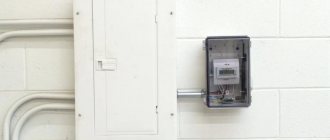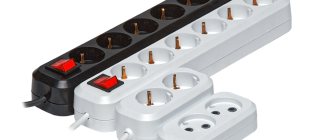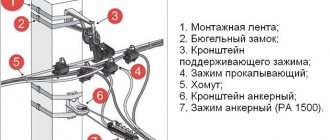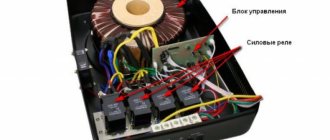Ammeter
An ammeter is a device for measuring current in an electrical circuit.
In terms of operation and appearance, an ammeter is very similar to a galvanometer. Its design has been modified so that it is possible not only to detect the presence of current in the circuit, but also to measure its strength .
In what units is the ammeter scale calibrated? Since it measures current, its scale will be graduated in amperes .
Different types of ammeters may differ from each other depending on the application. Figure 1, a shows a demonstration ammeter . Such devices are most often used in schools when demonstrating experiments.
Figure 1, b shows an ammeter, which is often used for laboratory work.
Figure 1. Demonstration and laboratory ammeters
As you can see, these two ammeters are designed to measure a specific range of current values. The scale of the first ammeter will show a maximum value of $3 \space A$, and the second - $2 \space A$. It is not recommended to exceed these values, as the devices may fail.
Conductors and dielectrics
Some divide the world into black and white, while we divide it into conductors and dielectrics.
- Conductors are materials that conduct electric current. The best conductors are metals.
- Dielectrics are materials that do not conduct electric current. Easy!
| Conductors | Dielectrics |
| Copper, iron, aluminum, tin, lead, gold, silver, chromium, nickel, tungsten | Air, distilled water, polyvinyl chloride, amber, glass, rubber, polyethylene, polypropylene, polyamide, dry wood, rubber |
Just because a dielectric doesn't conduct electricity doesn't mean it can't store charge. The accumulation of charge does not depend on the ability to transfer it.
Rules for connecting an ammeter to an electrical circuit
- The ammeter must be connected in series with the device/conductor in which the current is to be measured (Figure 3)
Figure 3. Series connection of an ammeter to an electrical circuit
- The ammeter has two terminals for connecting conductors. The terminal with the “+” sign must be connected to the wire coming from the positive pole of the current source. And, accordingly, the terminal with the “-” sign must be connected to the wire coming from the negative pole of the current source (Figure 4).
Figure 4. Correct connection of the ammeter, taking into account the positive and negative poles of the current source
- You cannot connect an ammeter to a circuit in which there is no current consumer (receiver) (Figure 5). This may cause the device to malfunction.
Figure 5. Impossibility of connecting an ammeter to a circuit without an electricity consumer
What measurement error should be?
Each measurement (for example, alternating and direct current or voltage) has its own error, which must be indicated in the product passport. On average, in household multimeters the error of all measurements “floats” in the range from 0.025 to 5%. For many of the measurements we make for simple tasks, an error of even 5% is not that great. However, it is still better to take a device with minimal errors.
Resanta DT 830B
Let's give an example: the Resanta DT 830B multimeter has a resistance measurement error of only 0.8%, while the more expensive IEK Professional MY61 device has as much as 5%. Of course, the device from IEK has many other useful functions that its cheaper brother does not have, but if the accuracy of resistance measurements is important to you, then it is better to take the DT 830B.
Measuring current with an ammeter
The first rule for connecting an ammeter to a circuit is that it is connected in series. Is there a difference where exactly with this connection we place the ammeter?
Let's assemble an electrical circuit. It will consist of a current source, a key, a light bulb and an ammeter (Figure 6).
Figure 6. Series connection of an ammeter (option No. 1)
After closing the circuit, we record the current strength shown by the ammeter.
Now let's move the ammeter in the circuit so that it stands after the lamp, and not before it (Figure 7).
The ammeter will show us the same current value as in the previous case.
Figure 7. Series connection of an ammeter (option No. 2)
Now let’s connect two ammeters to the circuit at once (Figure 8). And what will we see? They will show the same current values , exactly the same as in previous experiments.
Figure 8. Series connection of two ammeters in an electrical circuit
What does this tell us?
In a circuit with a series connection of conductors (so that the end of one conductor is connected to the beginning of another), the current strength in all parts of the circuit is the same.
Why is it the same? The fact is that the charge that passes through any cross section of the conductors of the circuit in $t = 1 \space s$ is the same. After all, the current flows evenly through all the wires of the circuit, without accumulating anywhere. Its flow can be compared to the flow of water through pipes.
Principle of operation
The first device was invented by Schweiger at the beginning of the 19th century, but it was then called a galvanometer. A drawing of a simple ammeter looks like this. On the axis of the bracket there is a steel anchor with an arrow. This structure is located parallel to a permanent magnet, which acts on the armature and gives it magnetic properties.
Lines of force run along the magnet and the arrow, which corresponds to the zero position on the scale. As soon as electric current begins to flow through the bus, a magnetic flux will be formed. Its field lines will be located perpendicular to the lines of the permanent magnet.
Under this influence, the armature will try to rotate 90°, and the magnetic flux will prevent it from returning to its original position. The interaction of magnetic fluxes depends on the magnitude and direction of the current that passes through the bus. According to this value, the needle will deviate from zero on the scale.
Safe and dangerous current limits
Working with electrical circuits can be dangerous if safety instructions are not followed. If we are talking about direct current (the magnitude of the current and its direction do not change over time), then the effects of such current on the human body are shown in Table 1.
| $I$, $ma$ | Impact on the human body |
| 0 — 3 | Not felt |
| 4 — 7 | Itching. Warming sensation |
| 8 — 10 | Increased heating |
| 11 — 25 | Even more intense heating, slight contractions of the arm muscles |
| 26 — 80 | Strong feeling of heating. Contractions of the arm muscles. Convulsions, difficulty breathing. |
| 81 — 100 | Respiratory paralysis |
Table 1. Effect of direct current on the human body
How to avoid getting injured when taking measurements?
To be on the safe side, if in doubt, it is better to read the instructions for the electrical appliance and check that the connection is correct. When taking measurements, it is important to remember about protective measures when working with electric current. Injury can occur even when working with low-current devices. Especially in conditions with high humidity. It is necessary to work in rubberized overalls.
You might be interested in Checking capacitor capacity with testers
To study ST, scientists came up with measuring electrical devices. Due to the low internal resistance, these meters do not affect the parameters of the electric current in the measured current circuit. The devices are actively used at industrial sites and at home.
Exercises
Exercise No. 1
When the ammeter was connected to the circuit as shown in Figure 9, a, the current strength was $0.5 \space A$.
What will be the readings of the ammeter when it is connected to the same circuit as shown in Figure 9, b? Figure 9. Options for connecting an ammeter to an electrical circuit
The current strength will be exactly the same. The ammeter will show a value of $0.5 \space A$. This is explained by the fact that in this electrical circuit all elements are connected in series. In this case, the current strength in all sections of the circuit is the same.
Exercise No. 2
How can you check the accuracy of an ammeter reading by using another ammeter that has been verified to be accurate?
It is possible to assemble a circuit as in Figure 6 using an accurate ammeter. Record the current value that it will show. Then replace it with another one, the one whose accuracy we want to check. Next, all that remains is to simply compare the readings of this ammeter with those obtained earlier.
You can do this in another way. To do this, you need to assemble a circuit, as in Figure 8, with serial connections of all elements. We already know that in such a circuit two working ammeters should show the same values . The main thing during such a check is to note for yourself which ammeter shows accurate measurement results, so as not to get confused.
Exercise #3
Consider the ammeters given in Figure 1. Determine the scale division value of each ammeter.
What is the highest current they can measure? Redraw the ammeter scale (see Figure 1, a) in your notebook and show what the position of the arrow will be at a current strength of $0.3 \space A$ and $1.5 \space A$. The scale of the demonstration ammeter from Figure 1, a, will have a division value equal to $0.2 \space A$.
The scale of the laboratory ammeter from Figure 1, b will have a division value equal to $0.05 \space A$.
In Figure 10, a we depicted the scale of a demonstration ammeter, which shows the value $I = 0.3 \space A$, and in Figure 10, b - $I = 1.5 \space A$.
Figure 10. Current values on the ammeter scale
What basic set of functions should a multimeter have?
Modern testers can have dozens of different functions, but in fact we only use a few at home. Here is a set of the most important functions, in our opinion, that should be in a multimeter:
- Checking DC and AC voltage . You can measure alternating voltage in the electrical network, checking for surges and under/overvoltage. “Constant” is necessary to measure the battery voltage.
- Checking DC and AC current . Although current measurements are not carried out at home very often, those devices that can measure voltage are usually “equipped” with a current measurement function. However, if you need to frequently check the load on the wires without turning off the voltage, then it is best to buy a current clamp for this purpose.
- Continuity of wires . This is the most useful feature for finding faults in a wire. With this feature, you can determine which specific core in a stranded wire is damaged and repair it accordingly. Continuity can be sound, light, or in the form of changes in readings in the device. Audio dialing is most convenient, since you don’t need to look at the screen. For inexpensive ones with audio dialing, we recommend purchasing Elitech MM 100 .
Elitech MM 100
- Resistance measurement . Let’s immediately make a reservation that for high-quality measurement of electronics resistance it is better to purchase a specialized ohmmeter. However, if you just need to measure the resistance on the phone board or in some electrical circuit, then a regular multimeter will be enough. The vast majority of devices have a resistance measurement function.
- Temperature measurement . At home, this function is most often used to measure the temperature at contacts (for substations it is better to take a specialized pyrometer). If the temperature is high, then the connection is heating up, which indicates poor contact between the conductors - which means you will need to unwind the twist, clean the wire and make a normal connection. Not all devices can measure temperature. The inexpensive DT 838 multimeter can measure temperature.
DT 838
This is the basic set of functions that a multimeter should have for comfortable use. However, there are many more additional functions and features that can be useful in certain jobs.
Digital Current Meters
Digital current meters, which are included in compact devices called multimeters, have recently become very popular. A multimeter can also measure voltage and resistance. Indication (display) of the measured value occurs in digital form with great accuracy. The indicators are either LEDs or liquid crystals.
Rice. 3. Digital multimeter










